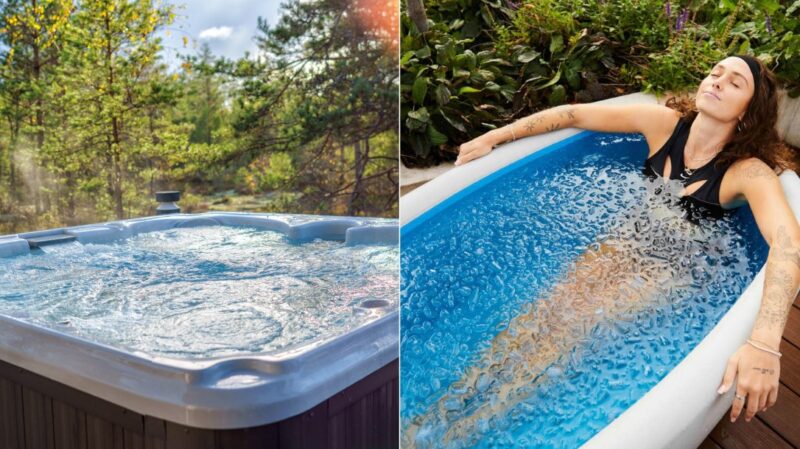When it comes to post-exercise recovery and overall wellness, the debate between hot tubs and ice baths has been ongoing among athletes, fitness enthusiasts, and health professionals.
After extensive research and consideration of the physiological impacts of both methods, it becomes evident that ice baths are superior to hot tubs in promoting muscle recovery, reducing inflammation, and enhancing athletic performance.
| Aspect | Hot Tubs | Ice Baths |
|---|---|---|
| Temperature Range | 100°F to 104°F (38°C to 40°C) | 50°F to 59°F (10°C to 15°C) |
| Primary Benefits | – Muscle relaxation – Stress relief – Improved flexibility |
– Reduced inflammation – Decreased muscle soreness – Faster recovery |
| Effect on Blood Vessels | Vasodilation (expansion of blood vessels) | Vasoconstriction (narrowing of blood vessels) |
| Impact on Recovery | May delay immediate recovery if used right after exercise due to increased inflammation | Accelerates recovery by reducing swelling and flushing out toxins |
| Ideal Timing for Use | – Several hours after exercise – On rest days |
Immediately after intense physical activity |
| Hydration Considerations | Can cause dehydration due to increased sweating | Minimal impact on hydration levels |
| Psychological Effects | – Promotes relaxation – Reduces stress |
– Enhances mood through endorphin release – Boosts mental resilience |
| Immune System Impact | Minimal direct impact | May enhance immune function by increasing white blood cell count |
| Risk Factors | – Overheating – Dehydration – Not suitable for certain cardiovascular conditions |
– Hypothermia if overexposed – Discomfort – Not suitable for certain cardiovascular conditions |
| Usage in Athletic Training | Commonly used for relaxation purposes | Widely adopted for post-exercise recovery among athletes |
The Superiority of Ice Baths Over Hot Tubs

Ice baths, or cold water immersion therapy, have gained significant popularity due to their profound effects on muscle recovery and performance enhancement.
The primary advantage of ice baths lies in their ability to reduce muscle inflammation and soreness following intense physical activity According to Healthline.
When muscles are subjected to strenuous exercise, micro-tears occur in the muscle fibers, leading to inflammation and delayed onset muscle soreness (DOMS).
Immersing the body in cold water causes vasoconstriction, narrowing the blood vessels, which helps decrease metabolic activity and reduce swelling in the muscle tissues.
In contrast, hot tubs, while offering relaxation and temporary relief from muscle tension, do not provide the same anti-inflammatory benefits.
The heat from hot tubs promotes vasodilation, increasing blood flow to the muscles.
While this can aid in muscle relaxation, it may also exacerbate inflammation immediately after intense exercise, potentially prolonging recovery time.
1. Reduction of Muscle Inflammation and Soreness
The primary benefit of ice baths is their ability to significantly reduce muscle inflammation.
The cold temperature constricts blood vessels, which helps flush out waste products like lactic acid that accumulate during exercise.
This process minimizes swelling and tissue breakdown, leading to a reduction in muscle soreness and stiffness.
2. Enhanced Recovery and Performance
Ice baths accelerate the recovery process by stimulating the central nervous system and reducing muscle fatigue. The cold immersion triggers a shift in hormone production, including an increase in norepinephrine levels, which enhances alertness and focus.
This hormonal response can improve subsequent athletic performance by preparing the body for the next training session.
3. Psychological Benefits
| Physiological Aspect | Hot Tubs | Ice Baths |
|---|---|---|
| Muscle Inflammation | Heat increases metabolic rate, potentially increasing inflammation if used immediately after exercise | Cold decreases metabolic activity, reducing inflammation and swelling |
| Blood Circulation | Increases circulation due to vasodilation, bringing more oxygen and nutrients over time | Initially decreases circulation due to vasoconstriction, then increases upon rewarming |
| Metabolic Waste Removal | Gradual removal through increased blood flow | Rapid flushing of waste products like lactic acid due to vasoconstriction and subsequent vasodilation |
| Nervous System Effects | Soothes nerves reduces muscle tension | Decreases nerve conduction velocity, reducing pain sensations |
| Hormonal Response | May reduce stress hormones over time | Increases norepinephrine levels, enhancing alertness and mood |
| Joint and Muscle Flexibility | Increases flexibility through muscle relaxation | May temporarily decrease flexibility due to muscle stiffness from cold |
| Pain Perception | Reduces pain through warmth and relaxation | Numb pain through reduced nerve activity |
| Energy Expenditure | Minimal impact on calorie burning | Slightly increases energy expenditure as the body works to maintain core temperature |
| Long-term Recovery Impact | Beneficial for relaxation and mental recovery | More effective for physical muscle recovery and performance readiness |
| Suitability for Injury Treatment | Not ideal for acute injuries due to increased blood flow | Effective for acute injuries to reduce swelling and pain |
Beyond the physical advantages, ice baths also offer psychological benefits. The initial discomfort of cold immersion can lead to the release of endorphins, the body’s natural painkillers, resulting in improved mood and reduced stress levels. This mental boost can be particularly beneficial for athletes who require not only physical readiness but also mental resilience.
4. Immune System Support
Exposure to cold temperatures has been linked to enhanced immune function. Cold water immersion can increase the production of white blood cells, which are crucial in fighting infections. A robust immune system is essential for athletes who are often at risk of illness due to the physical stresses of intense training.
Analyzing the Limitations of Hot Tubs

While hot tubs have their place in relaxation and stress relief, they are less effective for immediate post-exercise recovery. The heat can increase heart rate and promote blood flow, which, although beneficial for relaxation, may not be ideal for reducing muscle inflammation after strenuous activity. Additionally, prolonged exposure to high temperatures can lead to dehydration, which is counterproductive to recovery.
- Potential to Worsen Inflammation
- Risk of Dehydration
- Limited Impact on Muscle Recovery
Scientific Evidence Supporting Ice Baths
Multiple studies have reinforced the benefits of ice baths in athletic recovery
Research published in the NCBI demonstrated that athletes who engaged in cold water immersion experienced less muscle soreness and faster recovery times compared to those who used passive recovery methods.
Another study in the International Journal of Sports Medicine found that ice baths effectively reduced markers of muscle damage and inflammation.
These studies highlight the physiological mechanisms by which ice baths aid recovery:
- Vasoconstriction and Vasodilation Cycle: The initial constriction of blood vessels during cold immersion reduces swelling, while the subsequent vasodilation upon exiting the ice bath promotes fresh blood flow, delivering oxygen and nutrients to muscles.
- Reduction of Metabolic Activity: Lower temperatures decrease the metabolic rate within muscle tissues, slowing down the inflammatory processes that cause muscle soreness.
- Neuromuscular Benefits: Cold water immersion can reduce nerve conduction velocity, decreasing pain sensations and allowing muscles to relax more effectively.
Practical Application of Ice Baths

For optimal results, ice baths should be used correctly:
- Temperature and Duration: The water temperature should be between 50°F (10°C) and 59°F (15°C). Immersion should last for about 10-15 minutes to balance effectiveness and comfort.
- Frequency: Ice baths can be used after intense training sessions or competitions to facilitate recovery. However, they should not replace proper rest and nutrition.
- Safety Considerations: Individuals should monitor their body’s response to cold immersion, as excessive exposure can lead to hypothermia or other adverse effects. Those with cardiovascular conditions should consult a healthcare professional before using ice baths.
Maximizing Recovery with Combined Approaches
View this post on Instagram
While ice baths are superior immediately after exercise, incorporating hot tubs into a broader recovery strategy can be beneficial when timed appropriately:
- Delayed Use of Hot Tubs: Utilizing hot tubs several hours after exercise, or on rest days, can promote muscle relaxation and stress relief without interfering with the initial recovery process.
- Contrast Therapy: Alternating between hot and cold immersion (contrast water therapy) can enhance circulation and recovery. This method leverages the vasoconstriction and vasodilation effects to flush out metabolic waste and bring in nutrient-rich blood.
Conclusion
In the battle of hot tub versus ice bath, ice baths stand out as the better choice for promoting muscle recovery, reducing inflammation, and enhancing overall athletic performance.
The scientific evidence supports the use of cold water immersion as an effective strategy for mitigating the negative impacts of intense physical activity.
While hot tubs offer relaxation and can be part of a comprehensive recovery plan, they do not provide the immediate anti-inflammatory benefits essential for quick recovery.

